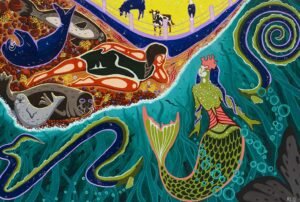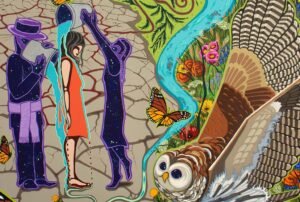
Editors’ note: This article is from the fall 2022 issue of the Nonprofit Quarterly, “The Face of Climate Change.”
Click here to download this article as it appears in the magazine, with accompanying artwork.
Women’s Rain Song
There below the mesas, the gentle rain comes,
turning the valley bright with lush green light.
There the female spirits of the cornstalks
wave their leaves, calling home
the unpredictable rain.1
The geography of Hopi society remains isolated from the fast-paced movement of urban life, placing us in our own microcosm of change and evolution, both ecologically and socially. But change, like nature, remains slow in our private corner of the world. I am a Hopi female raised culturally as a traditional food and farming practitioner. I come from generations of traditional farmers, seed savers, and food foragers. Through this experience, I learned to recognize and understand the strength of our Hopi agricultural systems—first, from the practical application of collecting, preserving, growing, processing, and eating from the land; then, as I matured in life, the deeper meaning and application of our social, religious, and spiritual food knowledge were taught to me. These teachings have never been separate from our relationship to the land, its changes, and its recovery; my worldview and spiritual upbringing shaped the lens through which I view my ecosystem, climate, and the changes that impact the space I occupy on tuwanasavi—the center of our world.
Hopi Agricultural Systems and Spiritual Food Knowledge
The Hopi people represent diverse groups of clans that migrated to the Black Mesa plateau in Northeastern Arizona, as part of a fulfillment of spiritual destiny and a covenant to maintain the land as the various clans settled the area. From these migrations, clans became a singular society with a shared worldview of Hopi religion across the village settlements. From that era on, each village carried its own history and jurisdiction of clans, including farming, hunting, and gathering territories.
Because of our long, sustained history in a singular location, the shared transgenerational memory of the Hopi farmer and seed saver brings a unique lens to both climate and societal change. Unlike Western culture, which sees things more clinically and from a one-dimensional trajectory of social change, Indigenous cultures look at the world multidimensionally, inclusive of the spiritual perspective.
For example, Hopis view the world and the human experience in cycles. In these cycles, we see change and recalibrate our understanding of change through the lens of natural laws that fluctuate like a pendulum between a state of balance and imbalance. These varying states often rely on the effect of our relationship to one another as human spirits, and on the living earth that hosts the plants, animals, and all of the elements that support life, such as soil, water, and air. So, when a farmer works hard to prepare and seed his field, and nothing grows despite the rain, the farmer must reflect on what is balanced and unbalanced in his life.2
Such reflection can be prompted when the plants do not grow to maturity because the field mice eat the seed, the corn dries before it pollinates, or the crows feast on the young corn before it can be harvested. These are lessons for the farmer that create a ripple effect on the nature of the farmer’s relationship to the land, and they demonstrate how the farmer’s life is reflected in the field, and how awareness of and connection to the land create the right symbiotic relationship that will make the crop successful. Every year, there are new lessons to learn.
Sign up for our free newsletters
Subscribe to NPQ's newsletters to have our top stories delivered directly to your inbox.
By signing up, you agree to our privacy policy and terms of use, and to receive messages from NPQ and our partners.
Spaces of “Knowing”
My relationship to the land is not as a climate “expert” but as an Indigenous seed saver, food preparer, and active participant in the farming culture of Hopi. My part in this long tradition is from the perspective of a female, knowing only specific aspects of the process that relate to my stewardship and preservation of seed and the processing and preparing of our harvest for food and spiritual use.
I learned to read the energy of the hustle and bustle of my community with the luminosity of the sun in the sky, and mark the time of year. These spaces of “knowing” are a part of me, just as are the air I breathe and the sustenance that comes from the land on which I live.Growing up in the High Desert region of Northeastern Arizona, I came to learn the land and its annual seasons like a clock. I learned to recognize the difference between the winter clouds and the summer clouds, and the simple nuances in the fragrances of plant life, and to know what time of year we are in because of what is ready to harvest. In the spring, women and children gather fresh greens, such as milkweed spinach, which is the first to present its seasonal bounty—and along with it, the special breads we make from blue cornmeal to complement its earthy flavors. As with many of our crops, there are multiple varieties of spinach plants that we harvest, and depending on the terrain, we learn in which soil each prefers to grow, so that we can find it.
I lived in a multigenerational home with my maternal grandparents, maternal uncle, mother, and brothers. What they taught me was a privilege of experiences I didn’t come to recognize until I became an adult. I was raised around the annual cycle of Hopi agricultural and ceremonial life since childhood, learning my role daily in supporting these systems. My grandparents expected me to help with shelling corn in late spring for the start of the big corn planting season, with food foraging of plants during the summers, and with cleaning the corn and preparing it for storage in the fall, before ceremonial events marked the time for the earth to take its winter rest.
Being raised in a farming family, I was often reminded that the seeds are my children. When we plant the seeds in Hopi soil, they grow strong and resilient to all things that try to harm their path to maturity.
I learned to read the energy of the hustle and bustle of my community with the luminosity of the sun in the sky, and mark the time of year. These spaces of “knowing” are a part of me, just as are the air I breathe and the sustenance that comes from the land on which I live. Moments like this throughout the year inspire an anticipation of change while pointing me forward to the next task at hand around our family activities or the preparing of food to contribute to events in my village.
The Seeds Are Our Children
Being raised in a farming family, I was often reminded that the seeds are my children. When we plant the seeds in Hopi soil, they grow strong and resilient to all things that try to harm their path to maturity. Hopi life philosophy is conveyed through such metaphors of raising corn in all its stages—the care as well as the risks that keep it from reaching maturity and fulfilling its purpose to the community. These philosophies bring out the practical nature in teaching simple and meaningful application vis-à-vis our relationship to the land and our resources.
Hopi farming technology, for example, includes a sooya (planting stick), a wikoro (watering gourd), sivosi (seeds), and the taaqa (male farmer). This technique of agriculture was honed over thousands of years with the simple tools that sustained generations of Hopi farmers. Today, with the introduction of new technology such as large farm machinery, it becomes more challenging to find balance with the impact to the land or our spiritual investment in the process. Using large machinery too much can create soil erosion, including loss of topsoil during the windy seasons. Traditional farmers who have accepted the use of new technology also choose to keep a balance by starting their fields and planting by hand, and finishing with a tractor. This serves to remind them that farming is a relationship with the seed and the soil.
As a food preparer, I was taught similarly. When preparing food, we do so with a good heart, so that this feeling will enter the food and fill others with that goodness, and strengthen them. If we are sad or angry, the food we prepare will not taste as good nor give the sustenance we want. In this way, the intentions of our work as farmers and food preparers are important to the spiritual life of our families and communities.
Climate Change and Impact on the Hopi World
The Hopi reservation has experienced an extended thirty-year drought—meaning that our normal rainfall of seven inches a year has decreased to extreme dry conditions of four inches or less rainfall per year.3 Over the last one hundred years, we had two significant droughts,4 but neither one extended as long as those of the past three decades.5 Since the 1990s, farmers have been able to bring home a harvest, but with a loss of nearly half of the crop to animals and/or extreme winds. Due to the dryness and lack of food and water, large animals such as elk and deer have roamed to lower elevations, where the fields are, to eat—competing with the usual animals we must keep away from our crops: gophers, quails, coyotes, and crows. The windy season that our farmers are accustomed to is usually in April, when the season changes from winter to spring. We call it the month of “Wind Row” planting, when farmers create barriers using dry plants to protect the early corn. Now, the windy season extends well into June.
In recent years, Hopi farmers have also experienced dry winters and late rainfalls, which no longer seem to align with our planting cycles. Farmers must risk planting early and experiencing a late frost or late monsoon season, either of which would be detrimental to their hard work and harvest. Most Hopi farmers rely solely on the winter soil moisture and summer monsoon season to water their crops. Today, some farmers have chosen to shift their traditional views on irrigation and have begun to haul water to their fields to sustain their crop. As a result, the last few decades have brought new challenges to our routines of harvest, as traditional food preparers are choosing to buy their corn and flour from neighboring tribes who have irrigated fields near rivers and areas less impacted by the drought.
Farming families work hard to prepare corn for storage for later use, and we are taught to keep at least four years of corn harvests in storage in case of drought or to prepare for major life events such as marriages, births, and ceremony. My household has not had a harvest in nearly three years. I follow the teachings I’ve learned and set aside seed for the next planting cycle, but in the past two years I’ve reduced my portion of seed each year, because the risk of loss in my community heirloom seed stock is too great for me. I have enough seed for one more planting season. This year, I will plan to buy my corn from neighboring tribes to meet what is needed to prepare food for the upcoming events. It is in these times that the teachings come forth and I begin to fully understand why we do this: why we save, why we work hard to have good storage for future years, and why we anticipate the years that may not produce a good harvest.
The Hopi worldview understands the connection to nature and the ebb and flow of the pendulum of change. I accept that Hopi teachings take the long view of things, and wait to observe when the pendulum of climate has shifted and we can look forward to an abundant season once again. As Hopi farmers and seed savers, we can no longer migrate, as we believe we have found our destined homelands. Instead, we must strengthen our roots by taking stock of our seeds, and adapt to the changes that we experience—always with faith that the pendulum will rebalance, and our constant self-reflection of our livelihoods will bring good rain to our fields and another year of bountiful harvest.
Notes
- Interpretation of a Hopi Women’s Rain
- Traditionally, Hopi farmers are However, if a family raises more daughters than sons, the daughters are involved to take on the responsibility, such as has occurred in my family.
- The experience of rainfall can vary based on the geographic regions on our Hopi reservation, as the area spans nearly 100 square I farm in a region with some of the lowest rainfall across the reservation. This reference is based on oral traditional knowledge from older generations of farmers who recalled the last long drought as being around the 1930s and extending almost twenty years. Smaller droughts have been experienced since, and the current one has impacted food storage. As the experience of climate and its effects is dependent on geographic location, and most studies are targeted to specific regions on the reservation, descriptions may not always reflect the totality of the various experiences of the Hopi farmer.
- I recollect oral traditional knowledge in gauging the last drought in the The second drought that specific regions of farmers began experiencing was in the late 1980s.
- Per my recollection, there may have been a couple of wet years between 1990 and 2010 that closed the term of the official drought; however, the dry season remained consistent, and my family was unable to grow crop at the same These are noted as an extension of a drought from the local farmer’s perspective.









